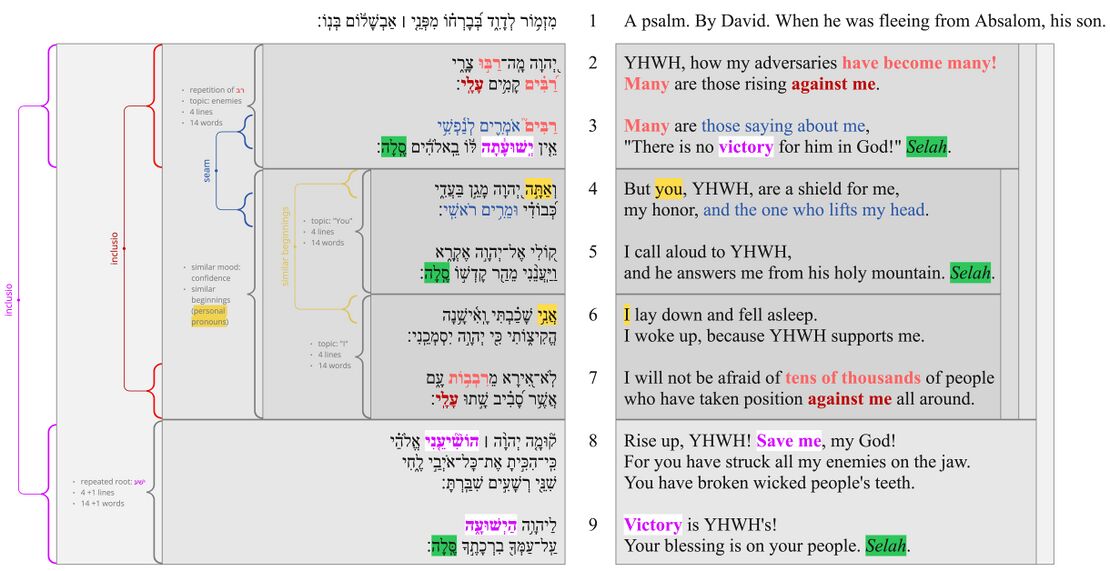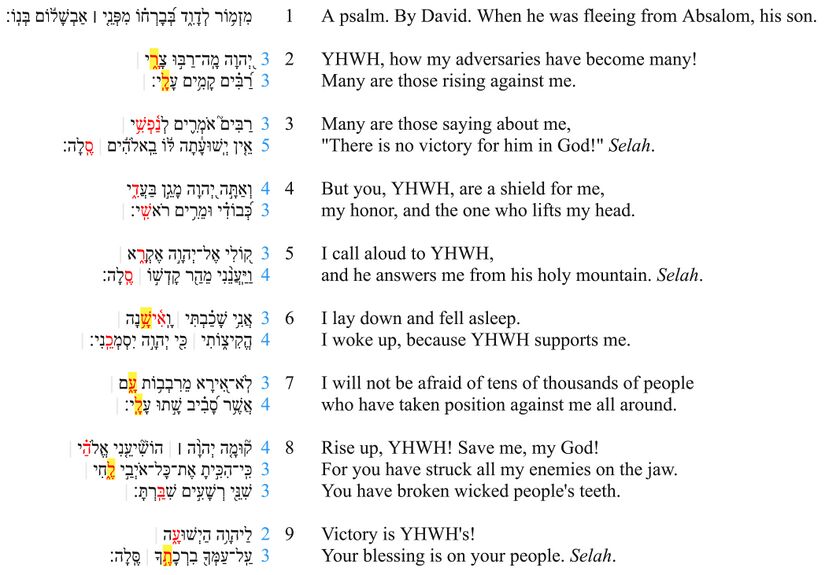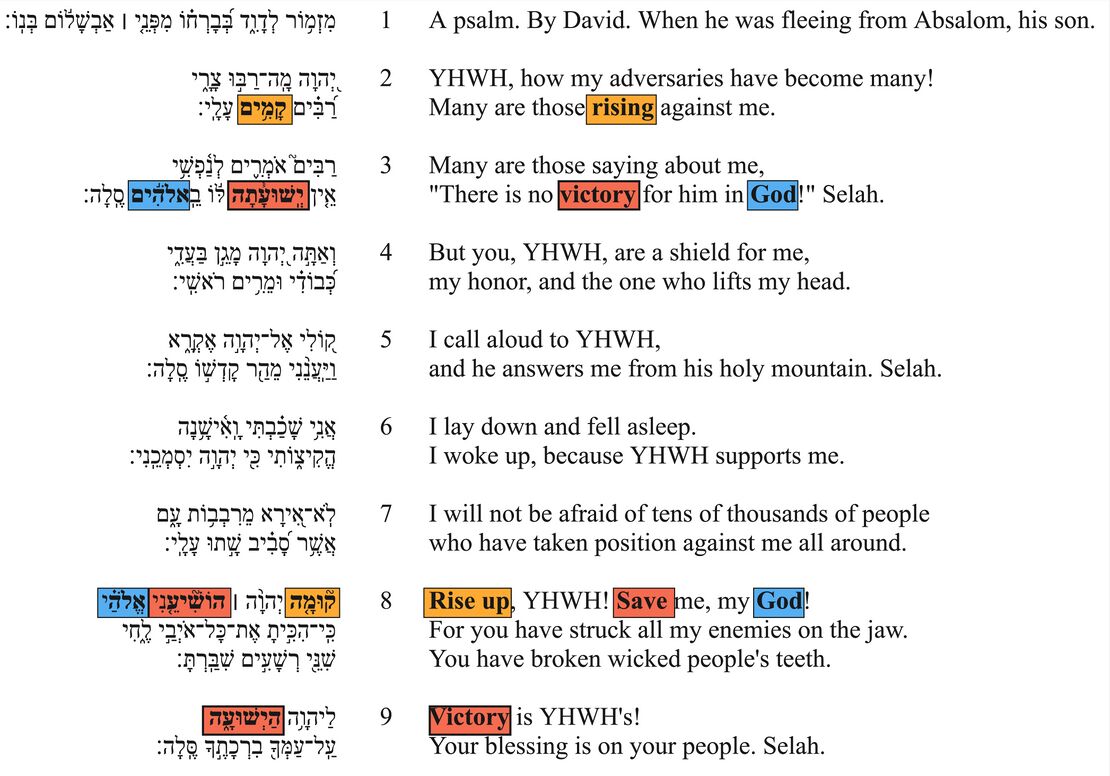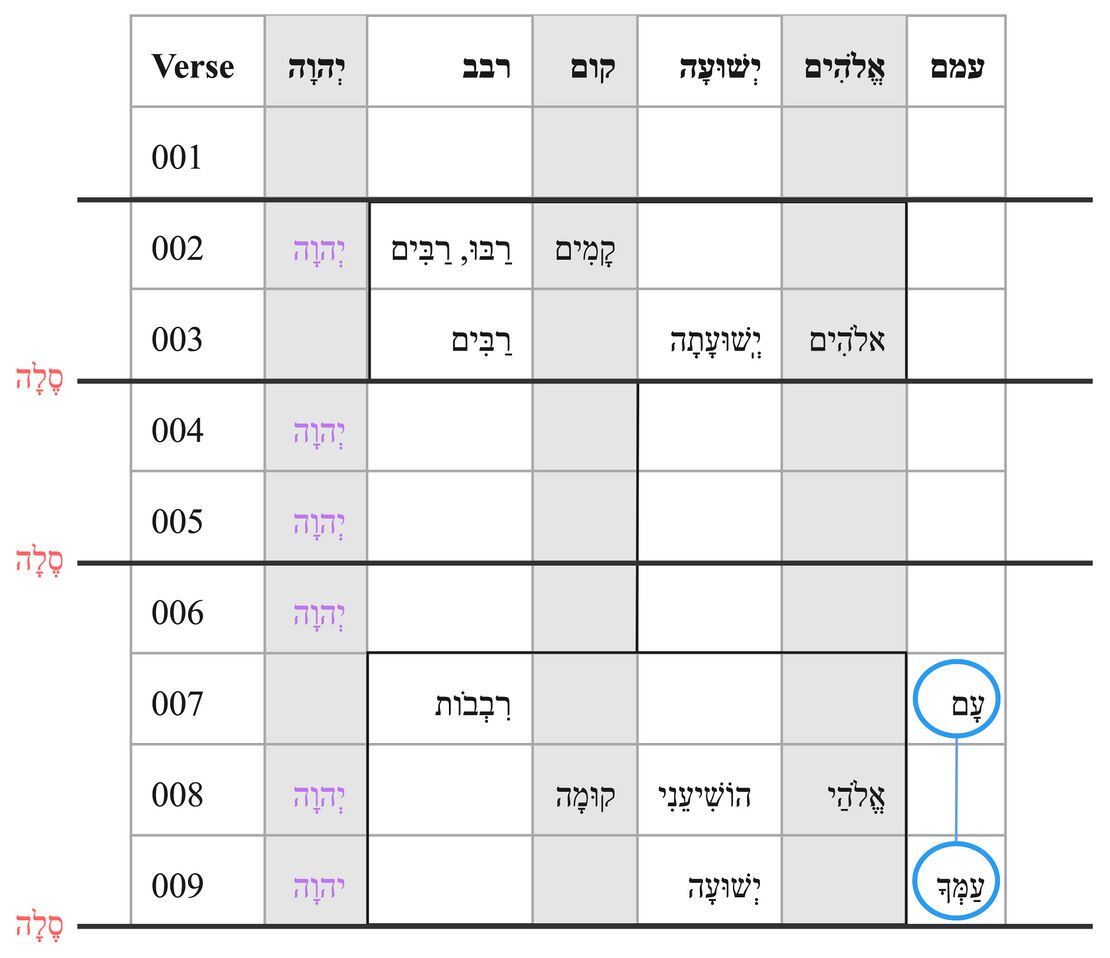Psalm 3 Poetry
About the Poetics Layer
Exploring the Psalms as poetry is crucial for understanding and experiencing the psalms and thus for faithfully translating them into another language. This layer is comprised of two main parts: Poetic Structure and Poetic Features.
Poetic Structure
In poetic structure, we analyse the structure of the psalm beginning at the most basic level of the structure: the line (also known as the “colon” or “hemistich”). Then, based on the perception of patterned similarities (and on the assumption that the whole psalm is structured hierarchically), we argue for the grouping of lines into verses, verses into sub-sections, sub-sections into larger sections, etc. Because patterned similarities might be of various kinds (syntactic, semantic, pragmatic, sonic) the analysis of poetic structure draws on all of the previous layers (especially the Discourse layer).
Poetic Macro-structure
If an emendation or revocalization is preferred, that emendation or revocalization will be marked in the Hebrew text of all the visuals.
| Emendations/Revocalizations legend | |
|---|---|
| *Emended text* | Emended text, text in which the consonants differ from the consonants of the Masoretic text, is indicated by blue asterisks on either side of the emendation. |
| *Revocalized text* | Revocalized text, text in which only the vowels differ from the vowels of the Masoretic text, is indicated by purple asterisks on either side of the revocalization. |
|
v. 1 A psalm. By David. When he was fleeing from Absalom, his son. |
Superscription |
|||
|
v. 2 YHWH, how my adversaries have become many! Many are those rising against me. |
Attack |
Many are rising against me. |
dismay |
|
|
v. 3 Many are those saying about me, There is no victory for him in God!" Selah. |
||||
|
v. 4 But you, YHWH, are a shield for me, my honor, and the one who lifts my head. |
Defense |
But you, YHWH, are a shield for me… |
confidence |
|
|
v. 5 I call aloud to YHWH, and he answers me from his holy mountain. Selah. |
||||
|
v. 6 I lay down and fell asleep. I woke up, because YHWH supports me. |
||||
|
v. 7 I will not be afraid of tens of thousands of people who have taken position against me all around. |
||||
|
v. 8 Rise up, YHWH! Save me, my God! For you have struck all my enemies on the jaw. You have broken wicked people's teeth. |
Victory |
Rise and save me, my God! |
triumph |
|
|
v. 9 Victory is YHWH's! Your blessing is on your people. Selah. |
||||
Notes
- The psalm divides into four sections (vv. 2-3, 4-5, 6-7, 8-9).[1] Other scholars have argued for a division into three sections (vv. 2-4, 5-7, 8-9).[2] In our view, the division into four sections better accounts for the discourse markers and repetitions in the psalm than the division into three sections (see notes below). Scholars who argue for the three-section division are right to note the continuity between v. 3 and v. 4 (see esp. the similar sounds between אֹמְרִ֪ים לְנַ֫פְשִׁ֥י and וּמֵרִ֥ים רֹאשִֽׁי; also the 2nd person address to YHWH), but this continuity is not strong enough to override the strong discontinuity between v. 3 and v. 4. Instead, the continuity functions at a higher level, creating a seam across disparate sections, binding the first section (vv. 2-3) to the two middle sections (vv. 4-7).
- The four-fold division is supported by the following:
- It accounts for obvious shifts in topic, emotion, and speech act:
- vv. 2-3—topic: enemies; emotion: distress; speech act: describing the distressing situation
- vv. 4-5—topic: YHWH ("You"); emotion: confidence; speech act: declaring confidence in YHWH
- vv. 6-7—topic: David ("I"); emotion: confidence; speech act: demonstrating confidence in YHWH
- vv. 8-9—topic: YHWH; emotion: confidence, triumph; speech act: asking YHWH to help.
- It accounts for the occurrences of selah, which helps to mark the end of sections 1, 2, and 4 (vv. 3b, 5b, 9b).
- It accounts for the occurrences of the divine name as a vocative, at the beginning of sections 1, 2, and 4 (vv. 2a, 4a, 8a).
- It results in a balanced structure. Each section is near the same length (4 lines, 14 words / 4 lines, 14 words / 4 lines, 14 words / 4+1 lines, 14+1 words). It is interesting to note that the recurring number 14 is the numerical value of David's name: dalet = 4; waw = 6; dalet = 4[3]).
- It accounts for the most striking repetitions and similarities in the psalm.
- The first section is bound together by similar content (repetition of root רבב, enemies as topic) as well as a possible inclusio ("YHWH... God").
- The second and third sections share similar beginnings; both begin with an independent personal pronoun (v. 4a: "you;" v. 6a: "I"). "You" (= YHWH) is the topic of the second section (vv. 4-5). "I" (= David) is the topic of the third section (vv. 6-7). These two sections also share a similar mood (confidence) and have a similar rhetorical function (declaring/demonstrating confidence in YHWH).
- The first section (vv. 2-3) and the two middle sections (vv. 4-7) are bound together by an inclusio (vv. 2, 7: "many... against me") and by a phonological seam (vv. 3-4, similar sounds between אֹמְרִ֪ים לְנַ֫פְשִׁ֥י and וּמֵרִ֥ים רֹאשִֽׁי).
- The final section (vv. 8-9) is bound together by the repetition of the root ישע (vv. 8a, 9a) and by its total word-count (15 words) which closely matches that of the previous sections. (The preceding sections create an expectation for a section of similar length.) The beginning of the final section is marked by the appearance of a three-line verse (v. 8) and a cluster of imperatives and a vocative (v. 8a). The final section also parallels the first section (vv. 2-3) in a number of ways. (See Poetic Features.)
- It accounts for obvious shifts in topic, emotion, and speech act:
Poetic Features
In poetic features, we identify and describe the “Top 3 Poetic Features” for each Psalm. Poetic features might include intricate patterns (e.g., chiasms), long range correspondences across the psalm, evocative uses of imagery, sound-plays, allusions to other parts of the Bible, and various other features or combinations of features. For each poetic feature, we describe both the formal aspects of the feature and the poetic effect of the feature. We assume that there is no one-to-one correspondence between a feature’s formal aspects and its effect, and that similar forms might have very different effects depending on their contexts. The effect of a poetic feature is best determined (subjectively) by a thoughtful examination of the feature against the background of the psalm’s overall message and purpose.
Rise and Save
If an emendation or revocalization is preferred, that emendation or revocalization will be marked in the Hebrew text of all the visuals.
| Emendations/Revocalizations legend | |
|---|---|
| *Emended text* | Emended text, text in which the consonants differ from the consonants of the Masoretic text, is indicated by blue asterisks on either side of the emendation. |
| *Revocalized text* | Revocalized text, text in which only the vowels differ from the vowels of the Masoretic text, is indicated by purple asterisks on either side of the revocalization. |
Feature
There are three words that appear only in the first section (vv. 2-3) and the final section (vv. 8-9) of the psalm: “rise”, “victory”/“save”, “God.”
The root for "victory/save" (ישע) is especially marked in this Psalm. Not only does it occur three times, but it occurs in unique forms. In v. 3 it has a unique suffix (יְֽשׁוּעָ֓תָה) and prosodic prominence (rare accent [shalshelet qatan] and occurrence of nesigah [shifting forward of the stress]). In v. 9 it occurs with the full definite article (הַיְשׁוּעָ֑ה, the only word in the Psalm with the full article).
Effect
The repetition of key words in this last section resolves the crisis and sets the record straight. The enemies may have been "rising" in v. 2, but they are no match for YHWH when, in v. 8, he is called to "rise." The enemies might say in v. 3 that “there is no victory/salvation for him in God,” but it is in vain: for David calls upon his “God” (v. 8) to “save” him, revealing the truth that, yes, there is indeed victory/salvation for him, because “victory/salvation belongs to YHWH” (v. 9a), and YHWH is his God.
Thus, the repetition sets up a contrast between the enemies' view of the situation and the reality of the situation. The enemies may act and speak as they like, but they are powerless when faced with YHWH. He will do as he pleases, and he will have the last word.
The Sounds of Silencing
If an emendation or revocalization is preferred, that emendation or revocalization will be marked in the Hebrew text of all the visuals.
| Emendations/Revocalizations legend | |
|---|---|
| *Emended text* | Emended text, text in which the consonants differ from the consonants of the Masoretic text, is indicated by blue asterisks on either side of the emendation. |
| *Revocalized text* | Revocalized text, text in which only the vowels differ from the vowels of the Masoretic text, is indicated by purple asterisks on either side of the revocalization. |
Feature
Verse 8 stands out in a number of ways:
- Poetic structure (the only three-line verse in the Psalm).
- Graphic imagery (striking jaws and breaking teeth).
- Dense alliteration (hard k in 8b [x3]; sh in 8c [x3]; both of which echo sounds in "rise" and "save" in 8a).
- Clustering of imperatives (8a), the only imperatives in the psalm.
- Chiastic patterning of v. 8bc based on syntax and semantics (a strike, b enemies, c jaw // c' teeth, b' wicked, a' shatter).
Effect
The effect of this clustering of poetic features is to draw attention to this climactic point in the psalm, where David calls on YHWH to take action against his enemies.
The repetition of the hard k sound in 8b mimics the sound of striking (also the repetition of the t sound in this line, as well as the ח sound), while the repetition of sh in 8c mimics the silence experienced by the now toothless enemies.[4]
Just as YHWH has struck and silenced every one of David's enemies in the past, so David calls on him to do it again. Those who mock him and his God (cf. v. 3) will be shamed and silenced.
Response to Taunts
If an emendation or revocalization is preferred, that emendation or revocalization will be marked in the Hebrew text of all the visuals.
| Emendations/Revocalizations legend | |
|---|---|
| *Emended text* | Emended text, text in which the consonants differ from the consonants of the Masoretic text, is indicated by blue asterisks on either side of the emendation. |
| *Revocalized text* | Revocalized text, text in which only the vowels differ from the vowels of the Masoretic text, is indicated by purple asterisks on either side of the revocalization. |
Feature
The first words of the second section (vv. 4-5) echo the last words of the first section (vv. 2-3). The words אֹמְרִים לְנַפְשִׁי in v. 3a are similar to וּמֵרִים רֹאשִׁי in v. 4b both in terms of sound (me + rim + shi) and morphology (participles). Similarly, the ending of יְֽשׁוּעָ֓תָה in v. 3b sounds like אַתָּ֣ה in v. 4a, and the words אֱלֹהִים (v. 3b) and יְהוָה (v. 4a) are semantically similar. There is also a subtle end-rhyme between אֵין and מָגֵן.
Effect
In terms of structure, this feature creates a chiasm (abba), which functions as a seam across the first two sections of the Psalm, binding them together into a larger whole. (See Poetic Structure.)
Rhetorically, the repetition of sounds (in reverse order) represents an undoing of the enemies' words. "The enemies' taunt that there is no salvation for the psalmist in God (v. 3) is answered in chiastic form by the psalmist's confident assertion of Yahweh's power to protect him ( v. 4)."[5]
Repeated Roots
The repeated roots table is intended to identify the roots which are repeated in the psalm.
| Repeated Roots legend | |
|---|---|
| Divine name | The divine name is indicated by bold purple text. |
| Roots bounding a section | Roots bounding a section, appearing in the first and last verse of a section, are indicated by bold red text. |
| Roots occurring primarily in the first section are indicated in a yellow box. | |
| Roots occurring primarily in the third section are indicated in a blue box. | |
| Roots connected across sections are indicated by a vertical gray line connecting the roots. | |
| Section boundaries are indicated by a horizontal black line across the chart. | |
Notes
- The divine name יְהוָה occurs six times.
- The repeated word סֶלָה occurs three times and defines three groups: vv. 2-3 [excluding v. 1 as superscription]; vv. 4-5; vv. 6-9. Most of the repeated roots, occur in the first and last group. There are no repeated roots in vv. 4-6, except for the divine name.
- A cluster of repeated roots occurs in vv. 2-3 and vv. 7-9:
- רבב (vv. 2-3, 7) x4
- ישׁע (vv. 3, 8-9) x3
- קום (vv. 2, 8) x2
- אלהים (vv. 3, 8) x2
- The word עָם repeats only in the last three verses of the psalm.
- The word יְשׁוּעָה is especially marked. Not only does the root ישׁע occur three times (vv. 3, 8-9), but the first occurrence has a rare morphology (יְשׁוּעָתָה) and the last occurrence has the definite article (הַיְשׁוּעָה).
Prominence Heatmap
| Hebrew | Verse | English |
|---|---|---|
| מִזְמ֥וֹר לְדָוִ֑ד בְּ֝בָרְח֗וֹ מִפְּנֵ֤י ׀ אַבְשָׁל֬וֹם בְּנֽוֹ׃ | 1 | A psalm. By David. When he was fleeing from Absalom, his son. |
| יְ֭הוָה מָֽה־רַבּ֣וּ צָרָ֑י | 2a | YHWH, how my adversaries have become many! |
| רַ֝בִּ֗ים קָמִ֥ים עָלָֽי׃ | 2b | Many are those rising against me. |
| רַבִּים֮ אֹמְרִ֪ים לְנַ֫פְשִׁ֥י | 3a | Many are those saying about me, |
| אֵ֤ין יְֽשׁוּעָ֓תָה לּ֬וֹ בֵֽאלֹהִ֬ים סֶֽלָה׃ | 3b | "There is no victory for him in God!" Selah. |
| וְאַתָּ֣ה יְ֭הוָה מָגֵ֣ן בַּעֲדִ֑י | 4a | But you, YHWH, are a shield for me, |
| כְּ֝בוֹדִ֗י וּמֵרִ֥ים רֹאשִֽׁי׃ | 4b | my honor, and the one who lifts my head. |
| ק֭וֹלִי אֶל־יְהוָ֣ה אֶקְרָ֑א | 5a | I call aloud to YHWH, |
| וַיַּֽעֲנֵ֨נִי מֵהַ֖ר קָדְשׁ֣וֹ סֶֽלָה׃ | 5b | and he answers me from his holy mountain. Selah. |
| אֲנִ֥י שָׁכַ֗בְתִּי וָֽאִ֫ישָׁ֥נָה | 6a | I lay down and fell asleep. |
| הֱקִיצ֑וֹתִי כִּ֖י יְהוָ֣ה יִסְמְכֵֽנִי׃ | 6b | I woke up, because YHWH supports me. |
| לֹֽא־אִ֭ירָא מֵרִבְב֥וֹת עָ֑ם | 7a | I will not be afraid of tens of thousands of people |
| אֲשֶׁ֥ר סָ֝בִ֗יב שָׁ֣תוּ עָלָֽי׃ | 7b | who have taken position against me all around. |
| ק֘וּמָ֤ה יְהוָ֨ה ׀ הוֹשִׁ֘יעֵ֤נִי אֱלֹהַ֗י | 8a | Rise up, YHWH! Save me, my God! |
| כִּֽי־הִכִּ֣יתָ אֶת־כָּל־אֹיְבַ֣י לֶ֑חִי | 8b | For you have struck all my enemies on the jaw. |
| שִׁנֵּ֖י רְשָׁעִ֣ים שִׁבַּֽרְתָּ׃ | 8c | You have broken wicked people's teeth. |
| לַיהוָ֥ה הַיְשׁוּעָ֑ה | 9a | Victory is YHWH's! |
| עַֽל־עַמְּךָ֖ בִרְכָתֶ֣ךָ סֶּֽלָה׃ | 9b | Your blessing is on your people. Selah. |
| Hebrew | Verse | English |
|---|---|---|
| מִזְמ֥וֹר לְדָוִ֑ד בְּ֝בָרְח֗וֹ מִפְּנֵ֤י ׀ אַבְשָׁל֬וֹם בְּנֽוֹ׃ | 1 | A psalm. By David. When he was fleeing from Absalom, his son. |
| יְ֭הוָה מָֽה־רַבּ֣וּ צָרָ֑י | 2a | YHWH, how my adversaries have become many! |
| רַ֝בִּ֗ים קָמִ֥ים עָלָֽי׃ | 2b | Many are those rising against me. |
| רַבִּים֮ אֹמְרִ֪ים לְנַ֫פְשִׁ֥י | 3a | Many are those saying about me, |
| אֵ֤ין יְֽשׁוּעָ֓תָה לּ֬וֹ בֵֽאלֹהִ֬ים סֶֽלָה׃ | 3b | "There is no victory for him in God!" Selah. |
| וְאַתָּ֣ה יְ֭הוָה מָגֵ֣ן בַּעֲדִ֑י | 4a | But you, YHWH, are a shield for me, |
| כְּ֝בוֹדִ֗י וּמֵרִ֥ים רֹאשִֽׁי׃ | 4b | my honor, and the one who lifts my head. |
| ק֭וֹלִי אֶל־יְהוָ֣ה אֶקְרָ֑א | 5a | I call aloud to YHWH, |
| וַיַּֽעֲנֵ֨נִי מֵהַ֖ר קָדְשׁ֣וֹ סֶֽלָה׃ | 5b | and he answers me from his holy mountain. Selah. |
| אֲנִ֥י שָׁכַ֗בְתִּי וָֽאִ֫ישָׁ֥נָה | 6a | I lay down and fell asleep. |
| הֱקִיצ֑וֹתִי כִּ֖י יְהוָ֣ה יִסְמְכֵֽנִי׃ | 6b | I woke up, because YHWH supports me. |
| לֹֽא־אִ֭ירָא מֵרִבְב֥וֹת עָ֑ם | 7a | I will not be afraid of tens of thousands of people |
| אֲשֶׁ֥ר סָ֝בִ֗יב שָׁ֣תוּ עָלָֽי׃ | 7b | who have taken position against me all around. |
| ק֘וּמָ֤ה יְהוָ֨ה ׀ הוֹשִׁ֘יעֵ֤נִי אֱלֹהַ֗י | 8a | Rise up, YHWH! Save me, my God! |
| כִּֽי־הִכִּ֣יתָ אֶת־כָּל־אֹיְבַ֣י לֶ֑חִי | 8b | For you have struck all my enemies on the jaw. |
| שִׁנֵּ֖י רְשָׁעִ֣ים שִׁבַּֽרְתָּ׃ | 8c | You have broken wicked people's teeth. |
| לַיהוָ֥ה הַיְשׁוּעָ֑ה | 9a | Victory is YHWH's! |
| עַֽל־עַמְּךָ֖ בִרְכָתֶ֣ךָ סֶּֽלָה׃ | 9b | Your blessing is on your people. Selah. |
Annotation type
| Hebrew | Verse | English |
|---|---|---|
| מִזְמ֥וֹר לְדָוִ֑ד בְּ֝בָרְח֗וֹ מִפְּנֵ֤י ׀ אַבְשָׁל֬וֹם בְּנֽוֹ׃ | 1 | A psalm. By David. When he was fleeing from Absalom, his son. |
| יְ֭הוָה מָֽה־רַבּ֣וּ צָרָ֑י | 2a | YHWH, how my adversaries have become many! |
| רַ֝בִּ֗ים קָמִ֥ים עָלָֽי׃ | 2b | Many are those rising against me. |
| רַבִּים֮ אֹמְרִ֪ים לְנַ֫פְשִׁ֥י | 3a | Many are those saying about me, |
| אֵ֤ין יְֽשׁוּעָ֓תָה לּ֬וֹ בֵֽאלֹהִ֬ים סֶֽלָה׃ | 3b | "There is no victory for him in God!" Selah. |
| וְאַתָּ֣ה יְ֭הוָה מָגֵ֣ן בַּעֲדִ֑י | 4a | But you, YHWH, are a shield for me, |
| כְּ֝בוֹדִ֗י וּמֵרִ֥ים רֹאשִֽׁי׃ | 4b | my honor, and the one who lifts my head. |
| ק֭וֹלִי אֶל־יְהוָ֣ה אֶקְרָ֑א | 5a | I call aloud to YHWH, |
| וַיַּֽעֲנֵ֨נִי מֵהַ֖ר קָדְשׁ֣וֹ סֶֽלָה׃ | 5b | and he answers me from his holy mountain. Selah. |
| אֲנִ֥י שָׁכַ֗בְתִּי וָֽאִ֫ישָׁ֥נָה | 6a | I lay down and fell asleep. |
| הֱקִיצ֑וֹתִי כִּ֖י יְהוָ֣ה יִסְמְכֵֽנִי׃ | 6b | I woke up, because YHWH supports me. |
| לֹֽא־אִ֭ירָא מֵרִבְב֥וֹת עָ֑ם | 7a | I will not be afraid of tens of thousands of people |
| אֲשֶׁ֥ר סָ֝בִ֗יב שָׁ֣תוּ עָלָֽי׃ | 7b | who have taken position against me all around. |
| ק֘וּמָ֤ה יְהוָ֨ה ׀ הוֹשִׁ֘יעֵ֤נִי אֱלֹהַ֗י | 8a | Rise up, YHWH! Save me, my God! |
| כִּֽי־הִכִּ֣יתָ אֶת־כָּל־אֹיְבַ֣י לֶ֑חִי | 8b | For you have struck all my enemies on the jaw. |
| שִׁנֵּ֖י רְשָׁעִ֣ים שִׁבַּֽרְתָּ׃ | 8c | You have broken wicked people's teeth. |
| לַיהוָ֥ה הַיְשׁוּעָ֑ה | 9a | Victory is YHWH's! |
| עַֽל־עַמְּךָ֖ בִרְכָתֶ֣ךָ סֶּֽלָה׃ | 9b | Your blessing is on your people. Selah. |
Annotation type
Bibliography
- Aejmelaeus, Anneli. 2024. “Translation Technique in the Greek Psalter.” In Editing the Greek Psalter, edited by Felix Albrecht and Reinhard G. Kratz, 41–60. De Septuaginta Investigationes. Göttingen: Vandenhoeck & Ruprecht.
- Anderson, A. A. 1972. The Book of Psalms. Vol. 1. NCBC. Greenwood, SC: Attic.
- Baethgen, Friedrich. 1904. Die Psalmen. Göttingen: Vandenhoeck und Ruprecht.
- Carbajosa, Ignacio. 2020. “10.3.4 Peshitta.” Textual History of the Bible. 2020.
- Delitzsch, Friedrich. 1920. Die lese- und schreibfehler im Alten Testament. Berlin ; Leipzig: De Gruyter.
- Goldingay, John. 2006. Psalms: Psalms 1–41. Vol. 1. BCOT. Grand Rapids: Baker Academic.
- Hardy, H. H. 2022. The Development of Biblical Hebrew Prepositions. Ancient Near East Monographs 28. Atlanta, GA: SBL Press.
- Hossfeld, Frank-Lothar, and Erich Zenger. 1993. Die Psalmen I: Psalm 1–50. Neue Echter Bibel. Würzburg: Echter.
- Hupfeld, Hermann. 1855. Die Psalmen. Vol. 1. Gotha: Friedrich Andreas Perthes.
- Ibn Ezra. Ibn Ezra on Psalms.
- Jenni, Ernst. 1992. Die Hebräischen Präpositionen Band 1: Die Präposition Beth. Stuttgart: W. Kohlhammer.
- Jenni, Ernst. 2000. Die Hebräischen Präpositionen Band 3: Die Präposition Lamed. Stuttgart: Verlag W. Kohlhammer.
- Kennicott, Benjamin. 1776. Vetus testamentum hebraicum : cum variis lectionibus.
- Kim, Young Bok. 2023. Hebrew Forms of Address: A Sociolinguistic Analysis. Atlanta: SBL Press.
- Kirtchuk, Pablo. 2011. “Onomatopoeia & Phono-Iconicity in Hebrew.”
- Kselman, John. 1987. “Psalm 3: A Structural and Literary Study.” The Catholic Biblical Quarterly 49 (4): 572–80.
- Locatell, Christian. 2019. “Causal Categories in Biblical Hebrew Discourse: A Cognitive Approach to Causal כי.” Journal of Northwest Semitic Languages 45 (2).
- Locatell, Christian S. 2017. “Grammatical Polysemy in the Hebrew Bible: A Cognitive Linguistic Approach to כי.” PhD Dissertation, Stellenbosch: University of Stellenbosch.
- Miller, Cynthia L. 2010. “Vocative Syntax in Biblical Hebrew Prose and Poetry: A Preliminary Analysis.” Semitic Studies 55 (1): 347–64.
- R. Moshe Yitzchak Ashkenazi. הואיל משה.
- Radak. Radak on Psalms.
- Rashi. Rashi on Psalms.
- Ryken, Leland, Jim Wilhoit, Tremper Longman, Colin Duriez, Douglas Penney, and Daniel G. Reid, eds. 1998. Dictionary of Biblical Imagery. Downers Grove, Ill: InterVarsity Press.
- Witthoff, David J. 2021. The Relationships of the Senses of נֶפֶשׁ in the Hebrew Bible: A Cognitive Linguistics Perspective. PhD Dissertation, University of Stellenbosch.
- Yeivin, Israel. 1980. Introduction to the Tiberian Masorah. Masoretic Studies, no. 5. Missoula, Mont: Published by Scholars Press for the Society of Biblical Literature and the International Organization for Masoretic Studies.













